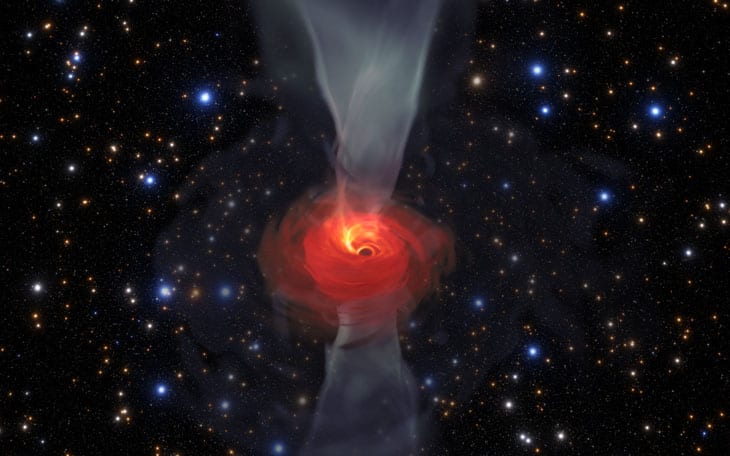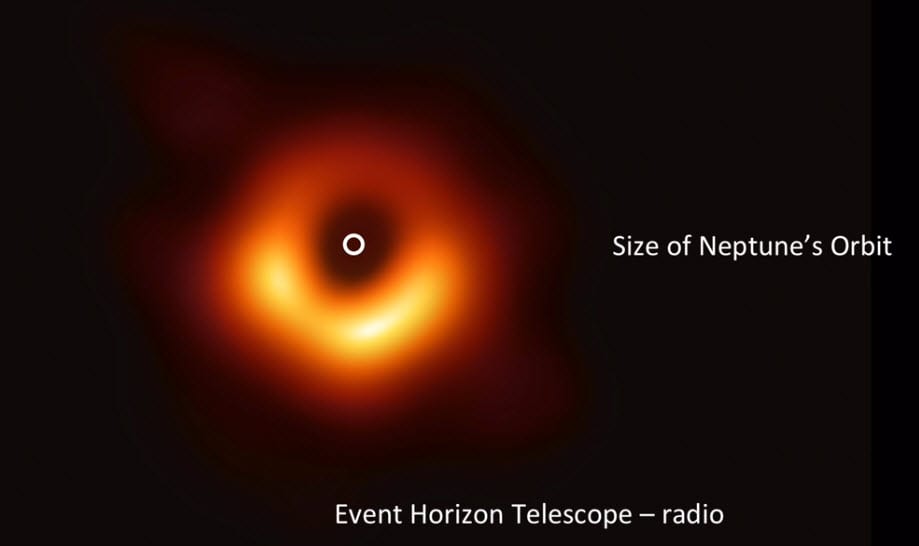By Chris Benton
With much excitement from the press, an international team of astronomers recently announced they had directly imaged the silhouette or shadow of a black hole for the first time. Chris Benton explains why this is important.
With much excitement from the press, an international team of astronomers recently announced they had directly imaged the silhouette or shadow of a black hole for the first time (Figure 1). This ground-breaking observation highlights many achievements including the new Event Horizon Telescope (EHT) and further supportive evidence for Einstein’s General Theory of Relativity.
Figure 1: Image of the silhouette of the SMBH at the heart of galaxy M87. The drawn inner circle represents the size of the orbit of our Solar System’s outermost planet Neptune, indicating the relative scale of the image. Credit: EHT
The EHT involves an international collaboration of scientists operating a network of eight large radio telescopes across the globe to synchronise and combine data as the world rotates to imitate a telescope the size of Earth. This process, known as very-long-baseline interferometry, allows high-resolution images such that one could read a newspaper in New York from a cafe in Paris, with the EHT target being a supermassive black hole (SMBH) at the centre of a relatively nearby galaxy known as M87.
SMBHs are enormous black holes with masses up to billions of times that of the Sun gravitationally collapsed to an infinitely small point and surrounded by a spherical region of space with intense gravity such that not even light can escape. The outer edge of that sphere is known as the event horizon, for any events beyond that point cannot be observed. Until recently, the existence of black holes has only been theoretical and inferred from the high-speed and highly elliptical orbits of nearby stars, plus the effects from the accretion disks of matter that form around them which can include bipolar jets of radiation as shown in Figure 2. While the inner edges of the accretion disks are at considerable distance from the event horizon, charged particles in these regions are spiralling around intense magnetic fields close to the speed of light, and in doing so, emit light at 1.3 mm radio wavelengths, known as synchrotron radiation. Some of this synchrotron radiation, instead of contributing to the bipolar jets, goes into unstable circular orbits around the black hole either crossing the event horizon or skimming around it.
Figure 2: An accretion disk of material surrounding a SMBH with emanating bipolar jets of radiation. Credit: Science News
The 1.3mm wavelength radiation in circular orbit is what we see in the highly-publicised image of Figure 1, but grossly amplified in size due to the effect of the black hole’s intense gravity warping space and bending the path that nearby light travels around it, much like eye lenses work. This effect, known as gravitational lensing, is another successful demonstration of Einstein’s General Theory of Relatively stating mass alters the geometric shape of spacetime, and in turn, predicts the very existence of black holes. With detailed analysis of the image, astronomers estimate the mass of M87’s SMBH as 6.5 billion times that of the Sun, and note that due to the gravitational distortion of light close to the black hole, the actual event horizon is approximately 2.6 times smaller than the demonstrated shadow.
Not only does this achievement herald a new exciting field of astronomy observing previously unseen regions of exotic and extreme physical properties, thus allowing the testing of high-energy physics theory, but it also reflects the many technical and geopolitical hurdles surmounted. The EHT represents years of construction and upgrading of large telescope arrays in remote places, plus the cooperation of numerous international teams of scientists collecting and calibrating data. The complexity and volume of data processed alone was unprecedented and, along with the increasingly sophisticated instruments involved and more telescopes joining the network, further development will lead to even more refinements and precision with future observations. We now wait for detailed images of Sagittarius A*, the SMBH at the centre of our galaxy: The Milky Way.
Chris Benton is a semi-retired General Practitioner studying for a Masters in Astronomy at Swinburne University in Melbourne. He is also a member of the Auckland Astronomical Society.
Disclaimer: The ideas expressed in this article reflect the author’s views and not necessarily the views of The Big Q.
You might also like:
What does The Goblin tell us about the outer reaches of our solar system?


